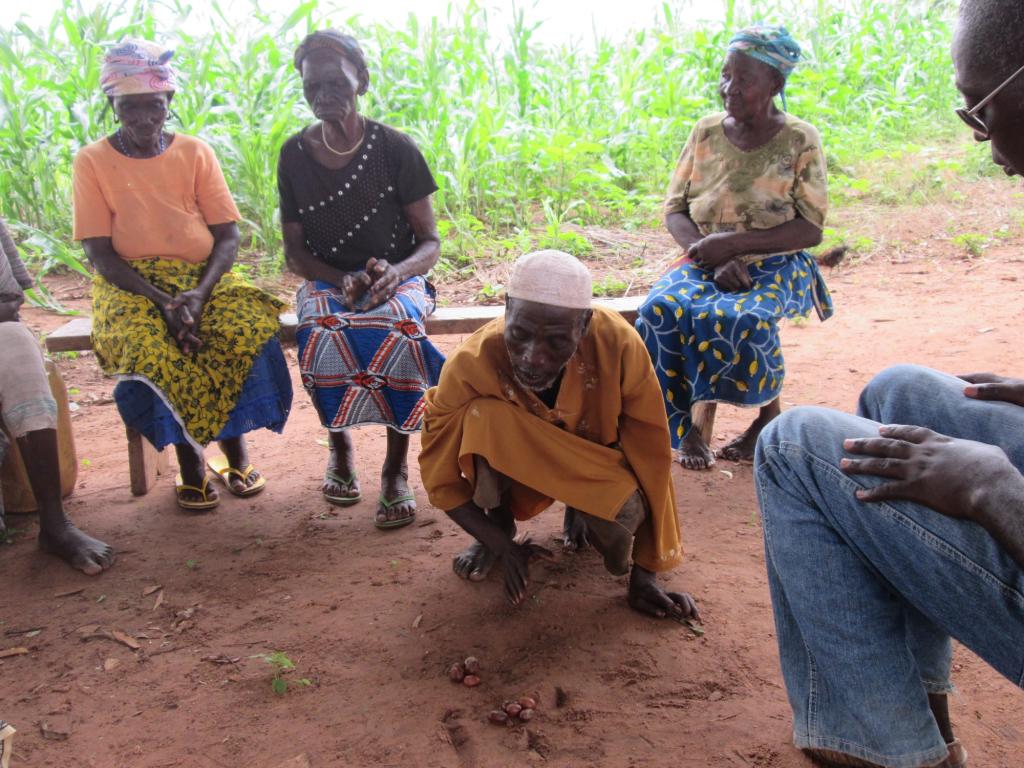How strong are climate adaptation knowledge systems in semi-arid regions?

By Mark New, Principal Investigator for ASSAR and the Director of the African Climate and Development Initiative at the University of Cape Town.
Knowledge is power. In the case of responding to weather and climate stresses – current and those coming down the road as climate continues to change – knowledge has been argued to be a critical enabling factor for climate adaptation.
What types of knowledge are important for climate adaptation? If one thinks of a typical adaptation process, information is needed on the climate risk, on its potential impacts and on possible response options to reduce risk. Knowledge across all these dimensions is a crucial component of adaptive capacity.

Using seeds to communicate importance of climate science (Image by Adelina Mensah – Ghana/ASSAR)
In the Adaptation at Scale in Semi-Arid Regions (ASSAR) project, we have been evaluating climate adaptation knowledge systems in countries such as Namibia, India and Kenya, within which vulnerable communities are embedded. We have developed a conceptual model of an adaptation knowledge system in which knowledge is generated, exchanged and used along several different dimensions. These range from local to national, regional spatial scales and actors, across timescales and along different steps in an iterative adaptation process – from weather and climate risks to identifying and adopting risk reduction options.
| A knowledge system is an “organised structure and dynamic process (a) generating and representing content, components, classes, or types of knowledge, that is (b) domain specific or characterised by domain-relevant features as defined by the user or consumer, (c) reinforced by a set of logical relationships that connect the content of knowledge to its value (utility), (d) enhanced by a set of iterative processes that enable the evolution, revision, adaptation, and advances, and (e) subject to criteria of relevance, reliability, and quality” (GSSD, accessed 2018). |
We are interested in strengths and weaknesses in these knowledge systems: are there common patterns in the systems across different locations that can tell us where effort should be concentrated to improve adaptive capacity? What are the underlying reasons for the strengths and weaknesses we find? Are there examples from locations of approaches that might be adopted in other settings to strengthen weak links in knowledge systems?
Dimensions of an Adaptation Knowledge System
We looked at the types of climate adaptation knowledge that are being generated, disseminated and/or exchanged at different system spatial scales – national, district and local levels in five different countries. We assessed the strength of the system on different climate risk timescales – from weather (days) to seasonal, decadal (one-ten years) and multi-decadal – and across different knowledge types or needs – climate and weather information, impacts, and adaptation response options.
Knowledge systems are stronger for shorter timescales, like weather forecasts
Across both time and space scales, the knowledge systems we looked at are stronger on shorter timescales, especially weather forecast scales, and weakest on longer timescales. The knowledge systems also tend to be strongest at national scales, where much of the resources and capacity for scientific knowledge generation and use lie. Local knowledge on weather and climate on shorter timescales is often quite strong, and increasingly becoming a hybrid of traditional knowledge and weather information that is provided by national or district services. Many local communities are only vaguely aware of climate change and what it means for them, and have asked for more information so that they can better understand how it might affect them.
The biggest gap in climate knowledge systems is on adaptation responses to climate risks and impacts
In most places there is knowledge on possible responses to weather and seasonal climate risks, but many local people are saying that their seasonal responses are becoming less useful as they observe changes in the timing and intensity of impactful weather events. As the risk horizon moves to multi-year and multi-decadal timescales, there is very little knowledge generated and, especially, exchanged between different actors in the knowledge system. There simply seems to be very little sharing of existing knowledge between projects and interventions that have been tried, and so diffusion of potentially useful adaptation solutions from trial to wider scales is slow or non-existent.
There tends to be a one-way flow of information from national to local scales
In many instances there tends to be a largely one-way flow of information from national to district to local, with very little “return-flow” of both ideas generated at the local, and feedback on the utility of what is provided. As noted in the definition of a knowledge system above, a strong knowledge system is characterised by “iterative processes that enable the evolution, revision, adaptation, and advances”. These learning and feedback loops seem to be missing in many knowledge systems that we looked at.
How can we build stronger adaptation knowledge systems? The biggest gap seems to be in the response space – knowing what to do when faced with an impending climate risk. There seems to be a need to build evidence on responses that have worked and share these more widely, as well as more effort in designing responses that are relevant and reliable in the context of those most at risk. Finally, where knowledge is already available – for example on climate risks and impacts – there is still much that can be done to strengthen both the relevance and accessibility of this knowledge, and to build strong feedback loops that allow for continual improvement in the knowledge system.
This article originally appeared on CARIAA's website